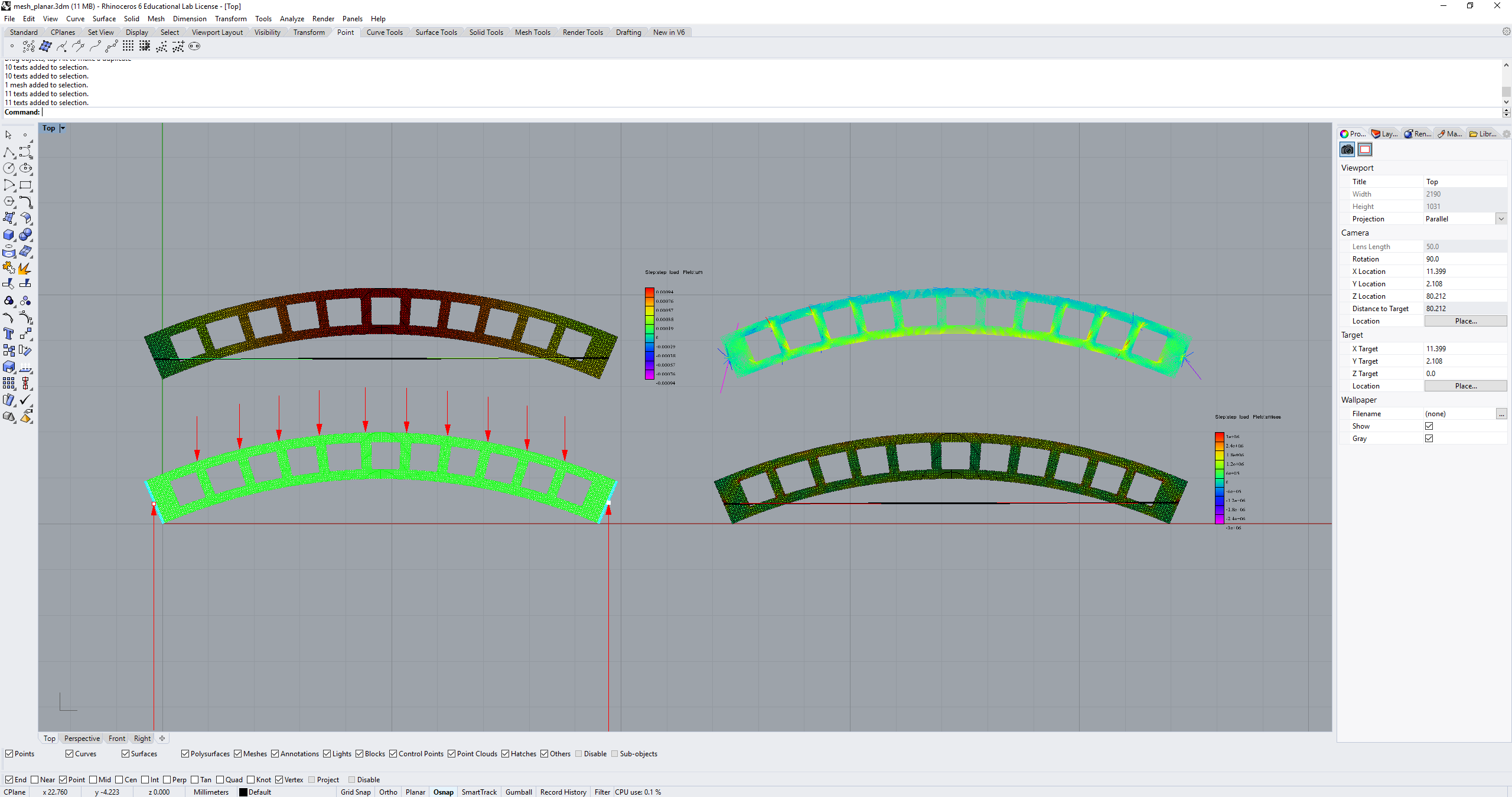mesh_planar
This example works for: Abaqus.
To run this example, download the Rhino file mesh_planar.3dm and copy the code in the Python editor in Rhino.

from compas_fea.cad import rhino
from compas_fea.structure import Concrete
from compas_fea.structure import ElementProperties as Properties
from compas_fea.structure import GeneralStep
from compas_fea.structure import PointLoads
from compas_fea.structure import PinnedDisplacement
from compas_fea.structure import PrestressLoad
from compas_fea.structure import RollerDisplacementX
from compas_fea.structure import ShellSection
from compas_fea.structure import Steel
from compas_fea.structure import TrussSection
from compas_fea.structure import Structure
import rhinoscriptsyntax as rs
# Author(s): Andrew Liew (github.com/andrewliew)
# Structure
mdl = Structure(name='mesh_planar', path='C:/Temp/')
# Elements
rhino.add_nodes_elements_from_layers(mdl, mesh_type='ShellElement', layers=['elset_mesh', 'elset_plates'])
rhino.add_nodes_elements_from_layers(mdl, line_type='TrussElement', layers=['elset_tie'])
# Sets
rhino.add_sets_from_layers(mdl, layers=['nset_pin', 'nset_roller'])
# Materials
mdl.add([
Concrete(name='mat_concrete', fck=50),
Steel(name='mat_steel', fy=460),
])
# Sections
mdl.add([
ShellSection(name='sec_planar', t=0.050),
TrussSection(name='sec_tie', A=0.0001),
])
# Properties
mdl.add([
Properties(name='ep_planar', material='mat_concrete', section='sec_planar', elset='elset_mesh'),
Properties(name='ep_plate', material='mat_steel', section='sec_planar', elset='elset_plates'),
Properties(name='ep_tie', material='mat_steel', section='sec_tie', elset='elset_tie'),
])
# Displacements
mdl.add([
PinnedDisplacement(name='disp_pin', nodes='nset_pin'),
RollerDisplacementX(name='disp_roller', nodes='nset_roller'),
])
# Loads
loads = {}
for i in rs.ObjectsByLayer('loads'):
loads[mdl.check_node_exists(rs.PointCoordinates(i))] = {'y': float(rs.ObjectName(i))}
mdl.add([
PointLoads(name='load_points', components=loads),
PrestressLoad(name='load_prestress', elements='elset_tie', sxx=50*10**6),
])
# Steps
mdl.add([
GeneralStep(name='step_bc', displacements=['disp_pin', 'disp_roller']),
GeneralStep(name='step_prestress', loads=['load_prestress']),
GeneralStep(name='step_load', loads=['load_points']),
])
mdl.steps_order = ['step_bc', 'step_prestress', 'step_load']
# Summary
mdl.summary()
# Run
mdl.analyse_and_extract(software='abaqus', fields=['u', 'cf', 's', 'rf'])
cbar1 = [-4*10**6, 0]
cbar2 = [0, 2*10**6]
rhino.plot_data(mdl, step='step_prestress', field='sminp', cbar=cbar1, radius=0.01)
rhino.plot_data(mdl, step='step_prestress', field='smaxp', cbar=cbar2, radius=0.01)
rhino.plot_data(mdl, step='step_load', field='sminp', cbar=cbar1, radius=0.01)
rhino.plot_data(mdl, step='step_load', field='smaxp', cbar=cbar2, radius=0.01)
rhino.plot_data(mdl, step='step_load', field='smises', cbar=cbar2, radius=0.01)
rhino.plot_data(mdl, step='step_load', field='um', radius=0.01)
rhino.plot_principal_stresses(mdl, step='step_load', ptype='max', scale=1)
rhino.plot_principal_stresses(mdl, step='step_load', ptype='min', scale=1, rotate=1)
rhino.plot_concentrated_forces(mdl, step='step_load')
rhino.plot_reaction_forces(mdl, step='step_load')